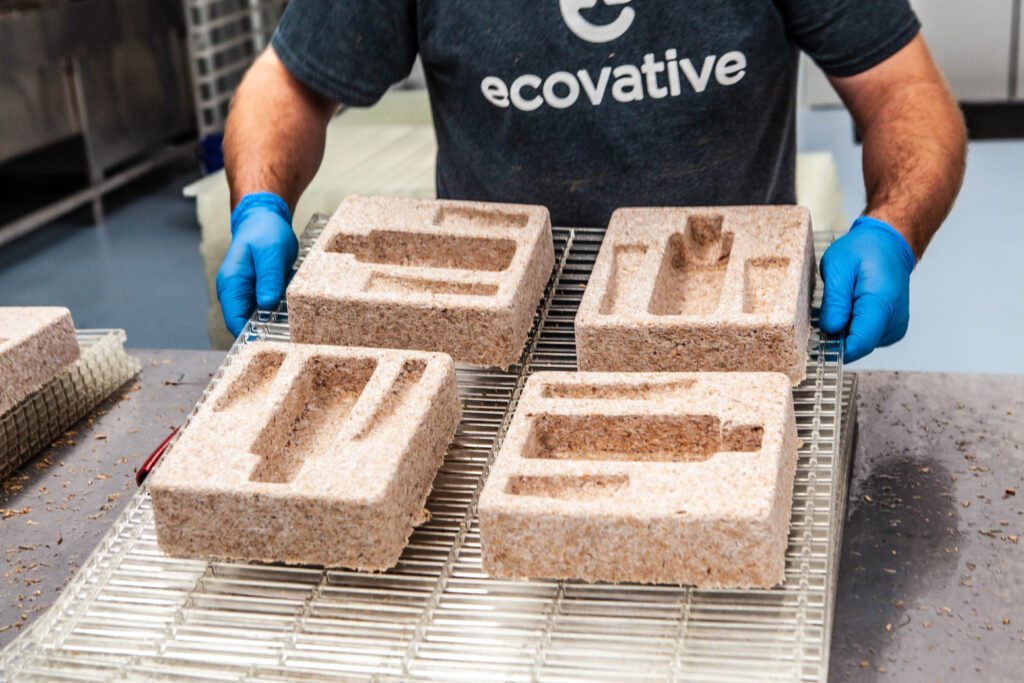In a world drowning in plastic pollution, mycelium packaging emerges as a groundbreaking, eco-friendly alternative that promises to revolutionize how we think about protective packaging. Derived from the root structure of mushrooms, this innovative material is capturing the attention of environmentalists, designers, and businesses seeking sustainable solutions.
Ecovative has stumbled upon this revolutionary material that is fully compostable at home. It is 100% natural, plastic free, water resistant and flame resistant.
What is Mycelium Packaging?
Mycelium packaging is a biodegradable material created from the intricate root networks of fungi. These microscopic threads, known as hyphae, can be grown into custom-shaped protective packaging that rivals traditional styrofoam and plastic in performance while offering unprecedented environmental benefits.
How Mycelium Packaging Works
The process is surprisingly simple yet ingenious:
- Agricultural waste (like corn stalks or hemp hurds) is used as a growth medium
- Mushroom mycelium spores are introduced to this substrate
- The mycelium grows and binds the waste materials together
- The material is then dried to stop growth, creating a sturdy packaging solution
Environmental Benefits of Mycelium Packaging
Biodegradability
Unlike traditional packaging that takes hundreds of years to decompose, mycelium packaging completely breaks down in weeks, returning nutrients to the soil without leaving harmful residues.
Carbon Footprint Reduction
The production of mycelium packaging requires significantly less energy compared to plastic or styrofoam manufacturing. It actually sequesters carbon during its growth process, making it a carbon-negative material.
Industrial Applications

Ecovative’s designers will generate a 3D model of your packaging and cut it to size with a CNC milling machine. The 3D model is then used to thermoform growth trays which are reused numerous times. The trays are filled with hemp, hurd and mycelium and allowed to grow for 4 days. The grown parts are removed from the tray and continue to grow for 2 more days to create a velvety layer of overgrowth. The parts are then dried to stop the growing process and is ready to be distributed.
Protective Packaging
Companies like Dell and IKEA have already experimented with mycelium packaging for product protection, demonstrating its potential to replace harmful packaging materials in shipping and logistics.
Cushioning and Insulation
Beyond packaging, mycelium materials offer excellent cushioning properties and natural insulation, making them versatile for various industrial applications.
Challenges and Future Potential
While mycelium packaging shows immense promise, challenges remain in scaling production and reducing costs. However, as technology advances and demand increases, experts predict mycelium could become a mainstream packaging solution within the next decade.
The Economic Opportunity
For businesses, adopting mycelium packaging isn’t just an environmental statement – it’s a strategic move. Consumers are increasingly demanding sustainable products, and companies that embrace innovative materials like mycelium can differentiate themselves in competitive markets.
Conclusion
Mycelium mushroom packaging represents more than just an alternative to plastic – it’s a glimpse into a more sustainable future. By harnessing the power of nature’s own design, we can create packaging solutions that protect both our products and our planet.

